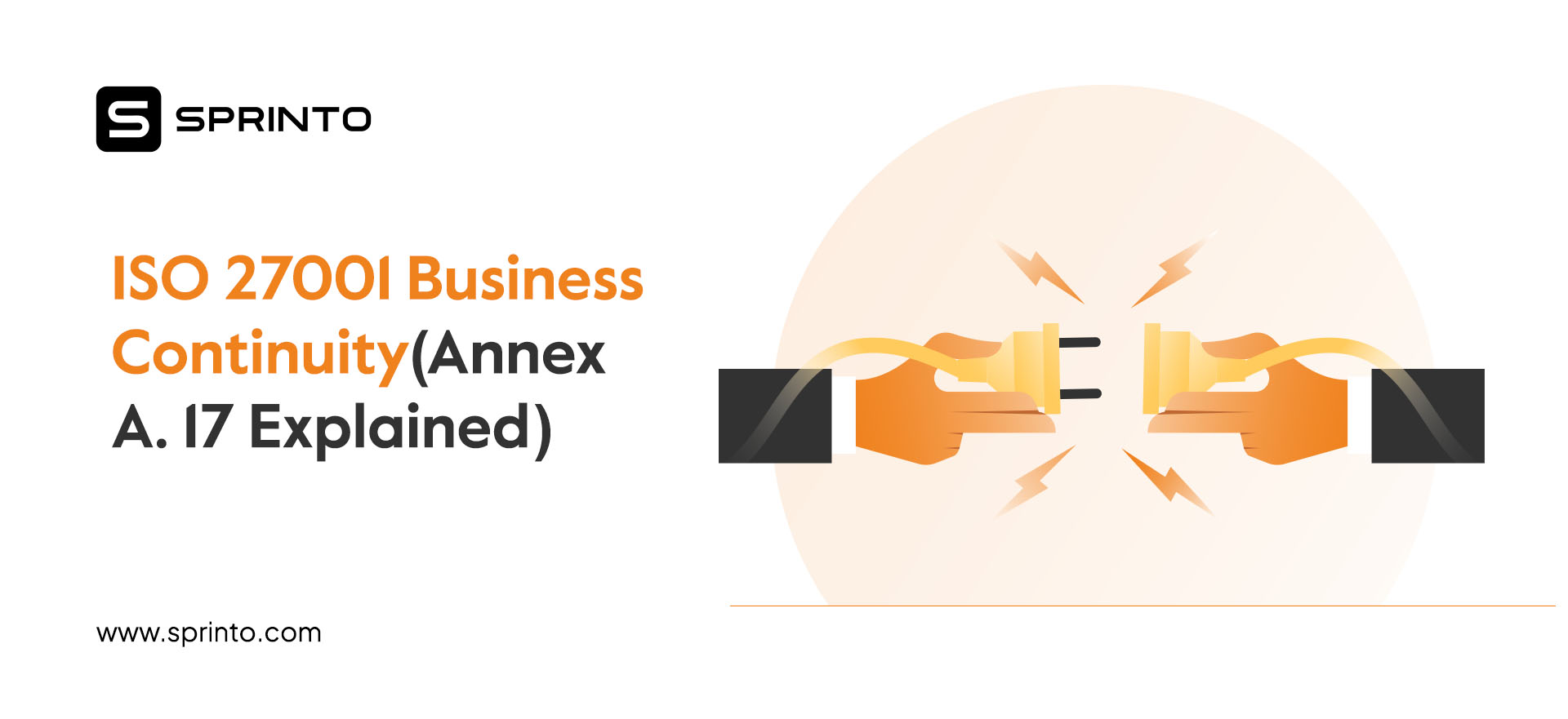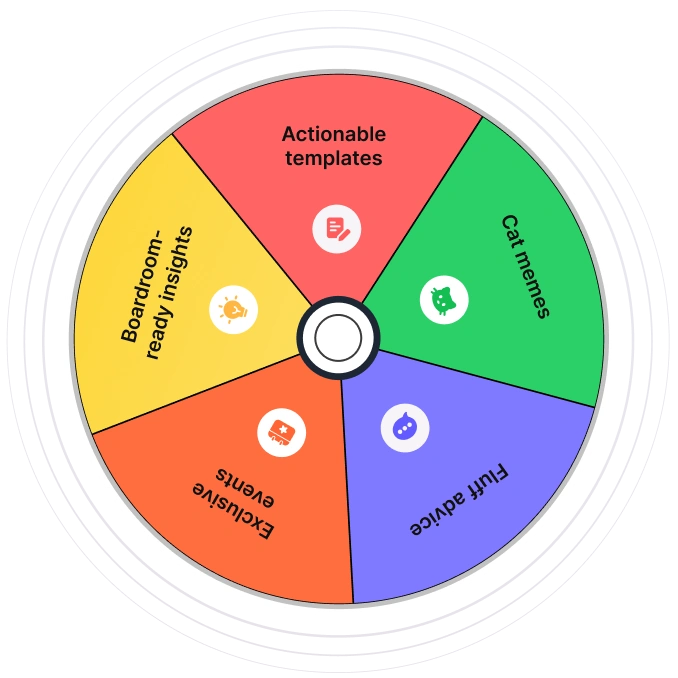In modern businesses, data and connectivity reign supreme and are considered the foundation that paves the path to success. Even the tiniest organizations rely heavily on technology, making any disruption a potential nightmare.
To highlight this, according to Datto, a mere hour of downtime can cripple small businesses with a cost of $10,000. For larger companies, those numbers skyrocket, reaching an astonishing $5 million or more. This is where ISO 27001 business continuity comes in.
It is also called Annex A.17 of the Annex A controls of ISO 27001 business continuity. Under this, people, places, and systems are united in pursuing uninterrupted operations. Let’s dive in to know more!
What is ISO 27001 Business Continuity Management?
Business Continuity Management is a vital process within ISO 27001 that helps your company identify risks to your operation and establish strategies to ensure you can respond swiftly when disaster strikes.

How does it work, you ask? You must implement a series of smart controls, like personnel training, data backups, and disaster recovery plans, all carefully outlined in Annex A.17 of Annex A controls.
Think of it as your go-to handbook for crafting policies and controls that ensure your business operations and information systems remain rock-solid, even during times of disaster.
Prepare for the unknown with our Business Continuity Plan Template. It’s designed to help you outline essential strategies to keep your business functioning during a crisis.
What is the objective of Annex A.17.1 of ISO 27001?
Annex A. 17.1 refers to the subject of information security continuity. The primary goal of this control within Annex A is to ensure that the organization’s business continuity management systems incorporate information security continuity measures.
If you aim to get ISO 27001 certified, this annex is a key requirement you must pay attention to. Now, let’s understand the requirements below:

A.17.1.1 Planning Information Security Continuity
Imagine a crisis or disaster striking your company. It could be a major data breach, a ransomware attack, a key person suddenly unavailable, or even flooding at the Head Office. Scary, right? That’s where planning for information security continuity becomes your secret weapon.
You need to determine your company’s specific requirements for safeguarding information security during any dire situation. While your existing Annex A controls might already protect you against some risks, there will always be the possibility of more hyper incidents.
Download ISO 27001 Information Security Policy
So, you must identify potential events and scenarios requiring strategic planning. Once you’ve done that, document your plan with details to show your company’s understanding and preparedness.
Note: ISO 22301 gives a structured approach to business continuity that aligns with the core requirements of ISO 27001.
A.17.1.2 Implementing Information Security Continuity
Planning alone won’t save the day. You need to put your plans into action. This means establishing, documenting, implementing, and maintaining processes, procedures, and controls that ensure continuity of information security during disruptive situations.
Once you’ve identified the specific requirements, implement policies, procedures, and even physical or technical controls.
You must also define responsibilities, activities, owners, and timeframes.
A.17.1.3 Verify, Review & Evaluate Information Security Continuity
It’s not enough to establish and implement information security continuity controls. You should also ensure their validity. Hence, regular intervals of testing and evaluating the controls are necessary to keep them up to par with changes in your business.
If you’re wondering why, it’s because the auditors will be looking for evidence of periodic testing, detailed logs of plan invocations and the subsequent actions taken. Moreover, your company should have a well-defined change management process to ensure your plans are consistently maintained.
Recommended: A complete guide to ISO 27001 compliance
How to write an ISO 27001 business continuity Plan?
While it’s tempting to go for the quick route and download a business continuity template, we’ll walk you through the writing process of ISO 27001 business continuity plan by yourself.
Here are the 10 points you should consider while write:
1. Create your version control and document mark-up
Before you begin, create a version control system for your ISO 27001 documents. This includes tracking the author, changes made, dates, and versions. Also, add document mark-up such as document classification for ease.
2. Write the policy purpose
Now, define the purpose of your ISO 27001 business continuity policy. To give you a hint, it’s designed to address threats, risks, and incidents that can potentially disrupt your operations.
3. Write the scope of the policy
Consider the scope of your business continuity policy. Ideally, it should apply to all employees and third-party staff associated with your company.
4. Write the principle on which the policy is based
Every policy needs a guiding principle; your business continuity policy is no exception. Here’s a powerful principle to consider: prioritize the safety of people above all else. This principle underscores the importance of protecting and supporting your workforce during disruption.
5. Define business continuity
Take a moment to clearly and concisely define what business continuity means for your company. You can also define any key terms or concepts used within the context of your business continuity efforts.
6. Describe your ISO 27001 business continuity plans
Outline what your plans cover, including the specific areas, processes, and systems they include. Highlight how they are structured for execution during times of crisis.
7. Recovery procedures
Assure your stakeholders that you have recovery procedures in place to restore normal operations following a business continuity event. They need to understand that you can bounce back stronger than ever.
8. Describe business continuity testing
Communicate whether, when, and how often you conduct ISO 27001 business continuity testing. Highlight the significance of evaluating your plans and fine-tune your response capabilities.
9. Describe the link to incident management
In this section, you have to state how incidents are managed and coordinated within the framework of your policy. This will integrate incident response and business continuity efforts.
10. Document your disaster recovery plans
Document the existence and importance of your disaster recovery plans. Stress that these plans are specifically designed to avoid the impact of potential disasters on your operations.
Recommended: Complete list of ISO 27001 requirements
Importance of business continuity management under ISO 27001
Business Continuity Management is an important component of ISO 2700. It enables your company to identify potential risks and vulnerabilities in their operations and establish effective strategies to ensure the continuity of their business in the face of emergencies, disasters, or unforeseen events
The importance of business continuity management under ISO 27001 is that it assists companies in identifying and mitigating potential risks that could jeopardize their operations.
This important process strengthens you against emergencies and uninterrupted continuation of business activities.
Don’t let your business become another statistic
With the implementation of Annex A Controls, you have a powerful weapon to minimize the need for a business continuity plan. While striving for an ISO 27001 compliant ISMS with robust risk-prevention measures is the goal, there may be instances where the contingencies outlined in A.17 become necessary.
But fear not, because our team of experts at Sprinto is here to support you in your organization’s information security approach. Take the first step towards enhanced protection by scheduling a no-obligation demo call with us today!
FAQs
What is BCP in ISO 27001?
BCP is the Business Continuity plan in ISO 27001 that outlines the procedure a company should follow in case of a disaster or disruption.
Is business continuity dealt with as part of ISMS?
Yes, business continuity is dealt with as a part of ISMS. This is especially important if you would like to achieve ISO 27001 certification soon.
What is the ISO standard for business continuity?
ISO 22301 is the standard for the business community. Its purpose is to ensure that an emergency procedure is initiated in the event of a serious incident to continue business operations.
Meeba Gracy
Meeba, an ISC2-certified cybersecurity specialist, passionately decodes and delivers impactful content on compliance and complex digital security matters. Adept at transforming intricate concepts into accessible insights, she’s committed to enlightening readers. Off the clock, she can be found with her nose in the latest thriller novel or exploring new haunts in the city.
Explore more ISO 27001 articles
ISO 27001 Overview & Requirements
ISO 27001 vs Other Frameworks
ISO 27001 Audit & Certification Process
ISO 27001 Management & Assessment
ISO 27001 Implementation & Automation
ISO 27001 Industry-Specific Applications
research & insights curated to help you earn a seat at the table.








